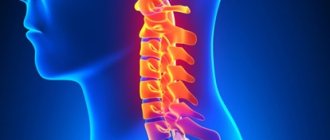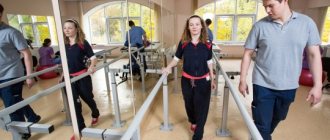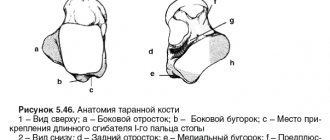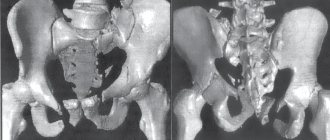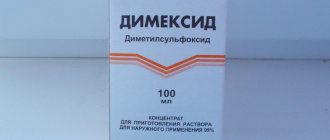The main manifestation of a postoperative hernia is the appearance of a tumor-like protrusion along the line of the postoperative scar and on its sides.
With sudden movements and physical stress, the hernia increases and painful sensations appear. In the lying position, the hernia decreases or disappears.
As the name implies, a postoperative hernia, or ventral hernia, develops as a consequence of surgery on the abdominal organs.
The appearance of postoperative hernias is associated with thinning of the muscles and connective tissue in the area of the postoperative scar, due to which the internal organs (intestines, greater omentum) protrude through the defects of the surgical scar beyond the abdominal wall under the skin.
The cause of the appearance of a postoperative hernia may be technical errors when applying a suture, non-compliance with recommendations for postoperative rehabilitation, as well as the individual characteristics of the patient (weakness of connective tissue, obesity, diabetes, etc.)
Why is it necessary to treat a postoperative hernia?
The very appearance of a hernia indicates that the organs have changed their location, and their normal mutual pressure on each other has been disrupted. This leads to disruption of the functions of all organs involved in the formation of a hernia.
Postoperative hernia is often accompanied by chronic constipation. Constipation, in turn, leads to general intoxication of the body and can affect the condition of the entire gastrointestinal tract.
Lack of treatment will eventually lead to serious complications
- coprostasis - stagnation of feces in the large intestine,
- inflammation of the hernia - inflammation of the organs located in the hernial sac,
- strangulated hernia - sudden compression of the hernial contents in the hernial orifice, leading to disruption of the blood supply to the organs in the hernial sac, and as a result - necrosis (death) of tissue. Strangulation of a postoperative hernia quite often (in 8.8% of cases) leads to death.
If a protrusion appears in the area of a postoperative scar, you should immediately consult a doctor, since it is much easier to treat a fresh hernia than one that has existed for a long time.
Over time, the hernia increases in size, the tissue surrounding it becomes thinner, so the operation becomes more complex, with a worse prognosis.
What symptoms to treat
You definitely need to consult a surgeon if you have the following symptoms:
- The appearance of a swelling or protrusion in the groin, abdomen, or scrotum, which increases with physical stress and disappears if you lie down.
- Feeling of heaviness, discomfort or pain in the protrusion area.
- The pain intensifies with lifting weights, walking, coughing and any other activity.
Our specialists treat all types of hernias, both in the initial stage and in the presence of complications.
Are there non-surgical methods for treating incisional hernia?
Treatment of postoperative hernia is carried out only with the help of surgery - hernioplasty. There are several methods used depending on the stage of development of the hernia.
The intervention must be performed as early as possible, because A long-existing hernia is prone to progression and the appearance of various complications.
The use of new technologies, the use of modern plastic and suture materials, and many years of experience of our surgeons guarantee the highest quality of operations to eliminate postoperative hernia, the absence of postoperative complications and relapse (recurrence of the disease).
List of published works on the topic of ventral hernias
- Puchkov K.V., Seliverstov D.V., Gausman B.Ya., Polit G.G., Strangulated supravesical internal median hernia // Clinical surgery. - 1993. - No. 4. — P.68.
- Puchkov K.V., Filimonov V.B., Tilov Kh.I. Surgical treatment of inguinal hernias using a mesh implant // Ros. magazine gastroenterology, hepatology, coloproctology. - 2002. - T.12, No. 5. — P.10.
- Puchkov K.V., Filimonov V.B., Tilov Kh.I. The use of a mesh implant for the surgical treatment of inguinal hernias // Current issues of herniology: materials of the conference. - M., 2003. - P.48.
- Puchkov K.V., Filimonov V.B., Bekk A.V., Tilov Kh.I., Shvalb A.P., Osipov V.V. Alloplasty of inguinal hernias with a polypropylene implant: experimental and clinical study // Pacific Med. magazine - 2003. - No. 1 (11). — P.81 — 83.
- Puchkov K.V., Filimonov V.B., Osipov V.V., Shvalb A.P., Ivanov V.V. Alloplasty of inguinal hernias using a polyprolene implant // Herniology. - 2004. - No. 1. — P.36 — 40.
- Puchkov K.V., Ivanov V.V., Bakov V.S., Usachev I.A. The use of polypropylene implants in herniology // 9th Moscow. international congr. in endoscopic surgery, Moscow, April 6 - 8. 2005: abstract. report / ed. Yu.I. Galingera. - M., 2005. - P.293 - 294.
- Puchkov K.V., Filimonov V.B. The use of modern implants in the surgical treatment of inguinal hernias: experimental data and clinical application // Current issues in specialized surgery: scientific and practical materials. conf. - Tashkent, 2007. - P.86 - 87.
- Puchkov K.V., Puchkov D.K. Evaluation of the results of using composite meshes in the treatment of postoperative ventral hernias // Materials of the International Scientific and Practical Conference “Endovideosurgery in a Multidisciplinary Hospital”, St. Petersburg: Publishing House “Man and His Health”, 2014 – pp. – 94 – 96. ISBN 978-5-9905495-4-8
- Puchkov K.V., Puchkov D.K. Results of the use of composite meshes in the treatment of postoperative ventral hernias // Almanac of the Institute of Surgery named after. A.V. Vishnevsky. T.10, No. 1 - 2015. “Materials of the XVIII Congress of the Society of Endoscopic Surgeons of Russia.” – Moscow, 2015. – P. 343-344.
Laparoscopic hernioplasty in 3D endoscopy (Professor K.V. Puchkov, April 2013 (Moscow). Laparoscopic repair of postoperative ventral hernia (Professor K.V. Puchkov, November 2012 (Moscow).
Postoperative hernia surgery
Operations for postoperative hernias are technically more complex and require highly qualified specialists, because surgical intervention is performed on tissues with scar changes.
Our clinic uses the most modern methods of treating postoperative hernias: for example, tension-free hernioplasty using the latest endoprostheses (including 3D), open and endoscopic hernioplasty.
Hernia repair using endoprosthesis
Hernioplasty is the most effective surgical method for treating hernia of the white line of the abdomen. During the operation, the defect of the postoperative scar through which the hernia emerges is closed with a special mesh endoprosthesis.
The foreign-made high-tech synthetic endoprostheses we use are very reliable, elastic, highly extensible and therefore do not limit the mobility of the abdominal wall.
The use of a mesh endoprosthesis protects the suture area from tension and thus provides three main advantages compared to the traditional surgical technique (tension plasty with local tissue):
- Extremely mild pain syndrome. Patients generally do not need to take pain medications after surgery.
- Short rehabilitation period. The patient goes home on his own the next day after the operation, and a month after the operation he can lift weights and play sports.
- Minimal risk of relapse. With proper placement of the endoprosthesis, recurrence of the hernia is practically impossible, whereas with the traditional technique it ranges from 6 to 14 percent.
The implant is not felt at all and does not cause any pain or discomfort.
Within a month after the operation, the mesh grows with connective tissue and over time, complete engraftment of the endoprosthesis occurs. The result is an anatomically unified complex that reliably closes the defect (weak spot) of the anterior abdominal wall and protects the tissue from repeated stretching.
We use two methods of installing an endoprosthesis: open and closed (endoscopic).
Open hernioplasty
With open hernioplasty, access to the contents of the hernia and the hernial orifice is through an external incision.
Next, hernia repair proceeds according to the following algorithm:
- isolation and opening of the sac with the contents of the hernia
- elimination of organ adhesions in the hernial sac, their reduction into the abdominal cavity
- removal of the hernial sac
- closing the hernial orifice using a special type of plastic surgery (hernioplasty)
- application and fastening of a special mesh implant of an individual shape
- if necessary, excision of the old postoperative scar, formation of a cosmetic intradermal suture with special suture material
Our surgeons always perform the operation taking into account aesthetic requirements: the incisions made are minimal, the instruments used are atraumatic, and the sutures are applied using ultra-thin suture material.
Endoscopic hernioplasty
The most modern and low-traumatic method of hernia removal is endoscopic, or closed, hernioplasty.
Endoscopic access in the treatment of postoperative hernias is widely used abroad.
This method is actively used in our clinic, since it has a number of undeniable advantages in the treatment of postoperative hernias:
- no risk of developing postoperative hernias at puncture sites,
- complete absence of pain syndrome,
- short recovery period (start of physical activity after a few days)
- the shortest rehabilitation period (one hundred percent return to active life in a maximum of two weeks)
- minimal number of relapses (less than 1%).
Unlike the classic open surgery technique, surgery is performed not through one large incision, but through three small punctures (0.5 - 0.6 cm).
Special endoscopic manipulators with a miniature video camera are inserted into them, sending an image to the monitor. With its help, the doctor monitors the progress of the operation.
The operation is carried out according to the same algorithm as with open access. But with endoscopic plastic surgery, a mesh implant is installed not through an external incision, but from inside the abdominal cavity at the site of the defect.
Endoscopic hernioplasty gives better results because... the location of the mesh on the side of the abdominal cavity more reliably protects the defect of the abdominal wall with an increase in intra-abdominal pressure.
This method of treating postoperative hernias is carried out using special expensive multilayer meshes. One of the layers of such a mesh is made of a special chemical compound that prevents the formation of adhesions between the endoprosthesis and the abdominal organs.
Abdominoplasty
If there are stretch marks, excess skin and subcutaneous fat on the abdomen, then it is recommended to combine the removal of a postoperative hernia with abdominoplasty.
This allows, simultaneously with hernia repair, to remove the skin-fat “apron”, eliminate sagging skin and stretch marks, and form a flat stomach and thin waist.
The operation to eliminate a postoperative hernia can also be supplemented with liposuction of the abdomen or other parts.
Advantages of using mesh implants
Contains modern materials
The materials from which the mesh is made are highly reliable and absolutely inert for the body. Thanks to their polymer composition, there is no rejection reaction by the patient's immune system.
No relapse guarantee
The number of relapses, repeated protrusion of the hernia, with mesh repair does not exceed 1-2%, while with repair with local tissues this happens 6-7% - 3 times more often.
Fast recovery
When fixing with mesh, there is no tissue tension, which promotes better healing and a significant reduction in pain, while with plastic surgery with local tissue, the edges of the hernial opening are tightened, and tension arises, which is fraught with postoperative pain and the cutting of sutures. About 80% of hernias are operated on on an outpatient basis in a one-day hospital
Anesthesia
Most of these operations are performed under spinal anesthesia, which is easily tolerated even by older people. Using highly effective modern drugs.
Cosmetic effect
Many patients are concerned that scars will remain, but during these operations the incision size is minimal: 6 cm for inguinal hernias, 3 cm for umbilical hernias. Cosmetic stitches are performed so that traces of the operation are almost invisible.
What is the most effective method for removing a postoperative hernia?
Our surgeons are fluent in endoscopic technology, but this technique is not always applicable for complex hernias. Often, much better results can be achieved by open hernioplasty.
Based on many years of experience in hernia repair, our surgeon will choose the optimal access method based on the characteristics of your particular disease.
The main factor in the successful outcome of hernia surgery is its impeccable technical execution. Poor surgical technique can ruin any method, even the best one. If all stages of the operation are performed correctly, then with any type of access the probability of hernia recurrence is minimal.
Features of installing a mesh for hernia and their types
To prevent recurrence of the hernia, the patient is sewn into a mesh that keeps the organs from falling out. This method of surgical intervention is called hernioplasty , and is considered the most effective in treating hernias.
Photo 1. A mesh prosthesis allows you to keep organs within their anatomical limits.
Postoperative hernia rehabilitation
Immediately after the operation, an elastic bandage is put on, which must be worn for a month.
At the BEAUTY DOCTOR clinic, patients are accommodated in single and double comfortable rooms.
The wards are equipped with continuous monitoring systems to monitor the patient's condition after surgery. Multifunctional beds create the opportunity to position and feed the patient after surgery in the most convenient position for him.
Each patient is provided with individual nursing care.
Since we use minimally invasive and maximally gentle techniques when repairing postoperative hernias, the postoperative period proceeds easily and without any special complications.
The next day after the operation, the patient goes home on his own, and after another 8-9 days comes for a follow-up examination and removal of sutures.
Two weeks after surgery, you are allowed to resume moderate physical activity (running, brisk walking). After endoscopic hernioplasty, such loads can be resumed within a few days.
A month after the operation, the patient can lead a normal lifestyle and play sports.
What do we treat
In the surgical department of GMS Hospital, the method of tension-free hernioplasty treats hernias of all types and locations:
- Inguinal hernia
- Femoral hernia
- Hiatal hernia
- Umbilical hernias
- Spigelian line hernias
- Postoperative hernias
- Hernia of the white line of the abdomen
- Diastasis of the rectus abdominis muscles
Surgeons at our Hernia Treatment Center use only high-quality endoprostheses from well-known manufacturers. When choosing an endoprosthesis, the doctor takes into account many factors: the type of hernia, stage and severity, existing complications, general condition of the patient, etc. Our specialists use both standard types of mesh implants and the latest 3D meshes.
Postoperative hernia surgery cost
| Postoperative hernia: hernioplasty | 46,000 rub. |
| Postoperative hernia: advanced hernioplasty | 51,000 rub. |
| Postoperative hernia: hernioplasty of recurrent hernia | 63,000 rub. |
| Postoperative hernia: endoscopic hernioplasty | 87,000 rub. |
| Hernioplasty with abdominoplasty | 260,000 190,000 rub. |
The cost of an operation to eliminate an incisional hernia includes all necessary examinations and dressings, as well as observation by a surgeon for six months after the operation.
Operations to remove a postoperative hernia are performed by highly qualified herniologist surgeons with extensive experience, trained in Russia and abroad:
| Gaboyan Aram Sergeevich, Doctor of Medical Sciences | Soboleva Polina Yurievna, Candidate of Medical Sciences | Malkarov Marat Azretovich, Candidate of Medical Sciences |
Preparing for surgery
At the preliminary consultation, the surgeon will set a date for the planned hernioplasty and a number of necessary studies - ECG, blood tests, urine tests, fluorography. You can undergo all the necessary tests and examinations at GMS Hospital within one day. If you regularly take medications, you should tell your doctor about this during your consultation; they may need to be temporarily discontinued.
Two weeks before the procedure, you must avoid alcohol and do not smoke on the day of surgery. Some operations require preliminary bowel preparation. The surgeon will tell you more about the preparatory stage during the consultation.
You have questions? We will be happy to answer any questions Coordinator Tatyana
Do you want to get rid of a hernia quickly and permanently?
You're lucky to have found us. Contact us for advice.
- We will conduct an in-depth diagnosis of the condition of your abdominal cavity
- We will select for you the optimal treatment method from the entire range of modern high-tech surgical techniques
- Our highly qualified specialists - candidates and doctors of medical sciences - will perform the operation using the latest technologies, expensive specialized equipment and materials
- Your stomach will become healthy and beautiful, and traces of the intervention will be completely invisible to prying eyes
- We will carry out follow-up examinations and monitor your abdominal condition for six months to ensure there is no recurrence (free of charge)
Features of the rehabilitation period
The high professionalism and long-term practice of surgeons, together with modern technical equipment, allows us to perform hernia repair with mesh in accordance with high international standards. The use of expert-level equipment, drugs and new generation materials ensures absolute safety.
The duration of bed rest after the intervention is limited to a couple of hours, after which it is allowed to get up. Immediately after the operation, you will be placed in a comfortable room, where you will be under the supervision of medical staff. Once the doctor is satisfied that you are feeling well, you will be discharged home.
After 1-2 days, discomfort disappears, and full working capacity, on average, will be restored 6 weeks after surgery. During this time, you need to remain calm, minimize physical stress, avoid visiting saunas, ponds, baths, and follow the diet prescribed by your doctor.
If you are in need of tension-free hernia repair and are looking for high-quality medical care, contact the Hernia Center at GMS Hospital. You can make an appointment with a surgeon online or by phone.
Why Euromed Clinic?
- Our surgeons have extensive experience in performing modern operations to remove ventral hernias and have all the necessary high-tech equipment.
- Euromed Clinic is a full-cycle clinic: all tests and studies can be done with us, and if necessary, you can quickly get advice from any specialist doctor (for example, a therapist or cardiologist).
- Thanks to modern technologies and clear logistics, you will not have to stay in the hospital for more than two days. Some operations can be performed in 1 day and do not require hospitalization.
